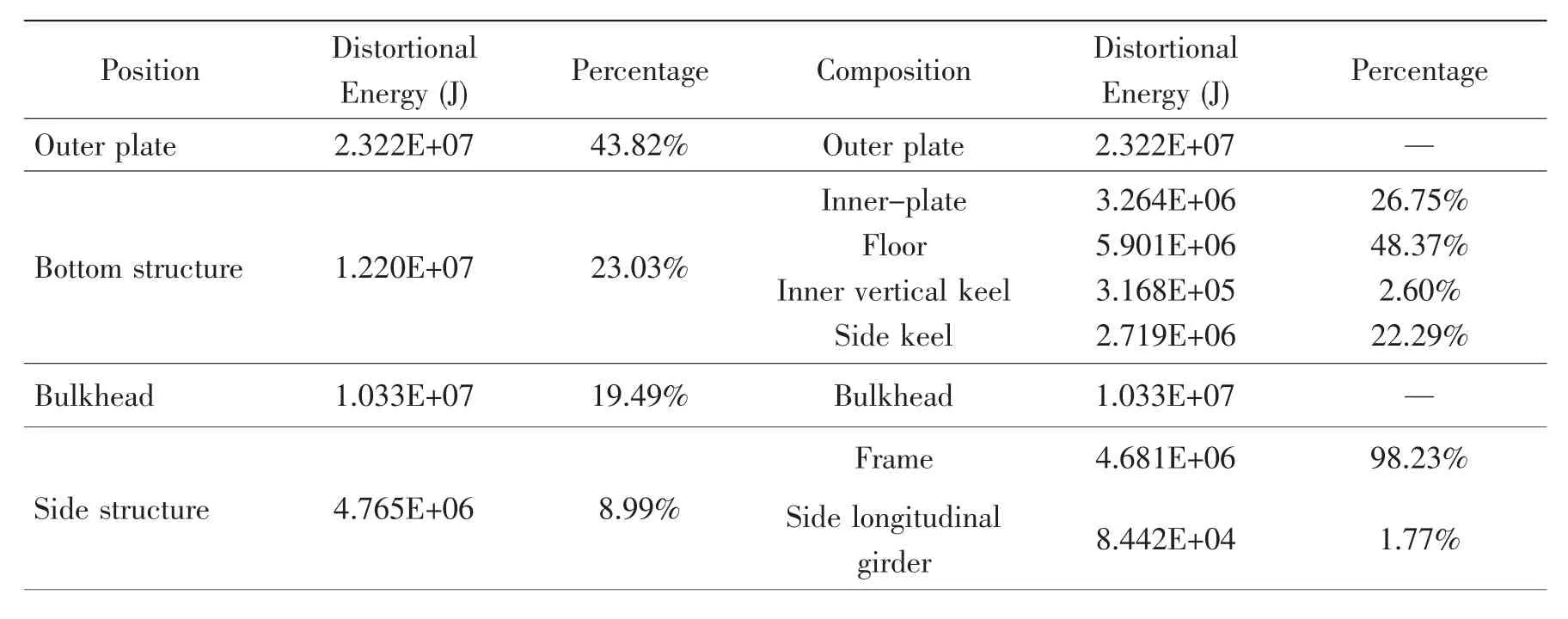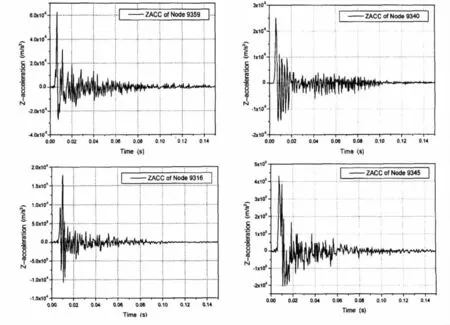Dynamic Response Analysis of a Warship Subjected to Underwater Explosion Shock Waves
2010-02-27CHENYongnianWANGCongTANJiahua
CHEN Yong-nian,WANG Cong,TAN Jia-hua
(1 School of Naval Architecture&Ocean Engineering,Shanghai Jiao Tong University,Shanghai 200030,China;2 Technology R&D Center,China Classification Society,Beijing 100007,China)
1 Introduction
Since the warship being in service can be attacked by non-contact explosives,such as torpedo,underwater bomb,etc.,the dynamic response and the deformation damage mechanism of the warship subjected to underwater explosion(UNDEX)shock waves have been the most concerns in the study of the improvement for the life and anti-impact capability.However,the UNDEX loading happens in a very short period of time,which leads to the dynamic response to be a complex large deformation and strong nonlinear problem,as well as the fluid-structure interaction.Consequently,it is difficult to analyze theoretically by utilizing the precise model,and to conduct the corresponding experiment due to the complicated equipment and expensive cost.Recently,with the development of computer technology,it is possible to carry out the numerical simulation by numerical method.In this paper,the dynamic response of a warship subjected to UNDEX loading has been investigated by using finite element modeling.
2 Underwater explosion(UNDEX)loading
During an underwater explosion,the charge instantly converts the explosive energy into hot gas of approximately 3 000℃and induces a shock pressure up to 5 000MPa[1].The sudden energy release associated with the explosion of a high explosive leads to the formation of a superheated,highly compressed gas bubble and the generation of a shock wave in the sur-rounding water.The underwater shock wave generated by the explosion is superimposed on the hydrostatic pressure.The shock energy delivered to the structure and produced by the underwater explosion is a function of the charge weight and the standoff distance.The shock pressure history at a given point has a sharp peak,followed by a decaying exponential curve,which is given by[1]

where Pmis the peak pressure of the shock wave,θ is the time decay constant,and t is the time since the shock wave front arrived at the target point.For TNT,the peak pressure Pmand the time decay constant θ are

where W is the explosive weight,R is the standoff distance,and k1, α1,k2and α2are the shock parameters of the explosive.
The shock energy flux density,which represents the shock energy flux across unit area of a surface at time t after a shock wave arrives,can be expressed as follows

where ρ is the density of water and c0is the speed of sound in water.Strictly,the pressure Pt(t)-P0,which is in excess of hydrostatic pressure P0should be used in this equation.But for most cases of interest,the shock wave pressure Ptis so large that the difference is of no importance.In order to give the energy for the whole process of the shock wave,generally t=6.7θ,then

The effectiveness of the shock wave depends on the time integral of the pressure,or impulse,which is more significant than on the detailed form of pressure versus time.The impulse of unit area of the shock wave front at a time t is given by

where l,β,m and γ are the shock parameters of the explosive.For TNT,the shock parameters are listed as Tab.1.
The initial gas pressure is considerably decreased after the principal part of the shock wave has been emitted,but it is still higher than the equilibrium hydrostatic pressure[1,6].12 gas bubble pulsations are observed using a detonator as the charge[2,7-8].The first bubble pulsecan have a peak pressure of 10-15 per cent of the shock wave peak pressure.During the pulsation process,the bubble migrates upward because of the influence of the gravity,with the maximum migration occurring during its minimal radius[3].The gas bubble generated by the explosion is nearly spherical during the initial expansion and contraction[4,12].The three characteristic parameters,reached during the first pulsation,are the maximum radius Rmax,the duration T of the pulsation(from the explosion to the first following minimum),the peak pressure of the bubble pressure Pbubble.Both vary with the size of the explosion charge and the depth at which the explosion occurs[5,9-11].

Tab.1 The shock parameters of the explosive

where H is the depth of the explosion in m.For TNT,k3=1.6,k4=985 and k5=7.24,here Rmaxis in m,T is in msec and Pbubbleis in MPa.
3 Fluid-structure interaction
In the linear approximation,the excess of hydrostatic pressure was a function of velocity potential.

where ρ0is the initial density of fluid,u is the velocity and φ is the velocity potential.
The velocity potential can be expressed as follows[1,6-7]:

here

where un(r′,t )is normal velocity,u0is the velocity of the incident shock wave.According to Eq.10

where P1is the incident shock wave.It can be found in the Eq.14,the pressure acting on the structure depends on not only the incident shock wave but also the fluid field condition out of the structure.If at any point out of the structure the un=0,then

here A0is the structure surface,unis the structure deformation velocity.

where W is the structure deformation.In the polar coordinates

For Integral Operators

For the underwater explosion,the duration of shock pressure is very short,t<θd,W(τ)=0,

For the bubble pressure,the t is so long that θdis not necessary to take into account in the calculation.

4 Finite element model
The ship structures are meshed by CQUAD4 shell element,which is a quadrilateral shell element with four grid points based on the Belytschko-Tsay formulation,and is the most common and efficient.Fig.1 shows the finite element model of the warship.The explosive located at the bottom of mid-ship section with the 10m distance to outer flat keel.The charge is 200kg TNT.

Fig.1 FEM of the warship
Considering the strong nonlinearities during the transient detonation,the material of the ship structure is defined by employing Cowper-Symonds rate enhancement formula[8].

where σdis the dynamic yield stress,σYis the static yield stress,and ε˙is the equivalent strain rate.The main particulars of ship structure are listed in Tab.2.

Tab.2 The main particulars of ship structure
5 Damage deformation
Different with the plan wave,underwater explosion shock wave is the spherical wave that decays very quickly,hence the damage deformation of ship structure subject to UNDEX loading has remarkable local characteristics,i.e.the deformation is concentrated in the area facing to the shock wave.Fig.2a shows the deformation of the ship structure.

Fig.2 Deformation of the ship structure
Although the bridge deck and the main deck structure are not directly subjected to explosion loading,but the UNDEX shock wave was delivered to the deck by the frame,and hence in the underwater explosion deck also has various degrees of deformation.From another point of view,the deck provides a good transverse support for the hull girder.Fig.2b gives the deformation of the deck.
Frame is the main transverse structure of the hull girder,under the loading of the UNDEX shock wave the frame plays an important role to bear the explosion force.The serious damage of the frame appears at the support point at the 2nd deck,see Fig.2c.
6 Plastic distortional energy
The curve for distortional energy of the ship structure is shown in Fig.3,with the corresponding data for each component of the ship listed in Tab.3,which represents the relative participation relation of different components involving in the action of the underwater explosion shock waves.For instance,the outer plate,the bottom structure and the transversal bulkhead are the main absorptive components and possess 43.82%,23.03%and 19.49%of the total distortional energy,respectively.However,the floor as a part of the bottom structure,absorbs 5.901E+06J distortional energy,which is nearly half of the total distortional energy of the entire bottom structure.Therefore,the floor is the main structure of the bottom to support the outer plate,and the transversal bulkhead is the main transversal support structure of the hull girder taking the role to transfer the UNDEX shock loading from the bottom structure to the deck structure.

Fig.3 Distortional energy history

Tab.3 Distortional energy summary

Continue
7 Acceleration response
With the continuous development of science and technology in a modern war,the level of information technology continues to enhance,the combat effectiveness of warship depends on the various complex precision instruments.Under the loading of UNDEX shock wave,the acceleration response of the structure is very huge,such huge impact acceleration will result in equipment damage,therefore the acceleration response of the structure must be given adequate attention.In this paper,six typical points were selected out,to obtain their respective acceleration response histories.The location of nodes are shown in Fig.4.

Fig.4 Location of typical nodes


Fig.5 Z-acceleration history
Under UNDEX shock loading,ship’s impact environment has the following characteristics:
(1)The UNDEX shock loading directly acts on the shell,the impact response of shell is high frequency and non-cyclical vibration.The acceleration response of structure away from the shell,such as the deck and the superstructure,is affected by the natural frequency of the structure.
(2)For the surface warship,the acceleration of structure under the waterline is far greater than that above waterline,because the underwater structure of the warship is subjected to the shock wave.
(3)At the same location,the shock acceleration peak of shell is 2 times that of the internal structure.
(4)The attacks on ships usually occur in underwater,the main impact response is mainly vertical,the horizontal impact response is about half of vertical,and the longitudinal impact response is about 1/4 of vertical.
8 Load transfer of the warship structure
The UNDEX shock wave is transferred to the frame through the shell and the longitudinal girder.Frame was supported by the deck beam at the transversal direction;frame and the deck beam formed a transversal framework of the hull girder.On the other hand,the deck structure supporting the hull girder at the transversal direction is also supported by the bulkhead at the longitudinal direction.At the bottom,the explosion loading was transferred to the floor by the plate and longitudinal girder of outer bottom.The floor was supported by the keel and inner bottom,because the bottom structure was supported by the bulkhead at the longitudinal direction,then the force is transferred to the deck through the bulkhead.The transfer process of UNDEX loading is shown in Fig.6.
9 Conclusions

Fig.6 Sketch-map of load transfer
(1)The damage deformation of the ship structure subjected to UNDEX loading has evidently local characteristics,with the deformation concentrated in the area facing to the shock wave.
(2)In view of the absorption of distortional energy,the shell,transversal frame and bulkhead are the major energy absorption components.From the view of the force transfer,outerplate and the longitudinal of the outer-plate undertake the impact loads directly,the bulkhead,transversal frame and the deck provide transversal support for the hull girder.
(3)The UNDEX loading will not only bring girder to the ship structure damage,but also make the ship produce huge acceleration response and lose battle effectiveness.The acceleration response of hull structure below waterline is far greater than the upper deck,and the acceleration mainly is in the vertical direction and located in the high frequency region.
[1]Cole P.Underwater explosion[M].Beining:National Defense Industry Press,1960.
[2]Johnson W,Poyton A,Singh H,Travis F W.Experiments in the underwater explosion stretch forming of clamped circular blanks[J].Int J Mech Sci,1966,8:237-270.
[3]Herring C.Theory of pulsation of gas bubble produced by an underwater explosion[J].Comp Underwater Explosion Res,1950,2:35-161.
[4]Keil A H.The response of ships to underwater explosions[J].Trans Soc Naval Archit Mar Eng,1961,69:366-410.
[5]Keil A H.Introduction to underwater explosion research[M].UERD,Norfolk Naval Ship Yard,Portsmouth,Virginia,1956.
[6]Ezra A A.Principles and practice of explosive metal working[M].Vol.1.Adelphi,London,WC2N 6JH:Industrial News Papers Ltd.,John Adams House,1973.
[7]Kennard A H.The effect of pressure wave on a plate or diaphragm[J].Comp Underwater Explosion Res ONR,1944,3:11-64.
[8]Young W C.Roark’s formulas for strain and stress[M].7th Edition.McGraw-Hill Companies Inc.,2005.
[9]Zhang Xiaoci.Similarity criteria for experiment of underwater explosion[J].Journal of Ship Mechanics,2007,11(1):108-118.
[10]Zhang Aman,Yao Xiongliang.Stability of numerical model of the bubble dynamics[J].Journal of Ship Mechanics.2008,12(3):323-334.
[11]Zhang Xiaoci.Scaling law for experiment of underwater explosion with several independent geometrical scales[J].Journal of Ship Mechanics,2008,12(3):490-499.
[12]Zong Zhi,He Liang,Sun Longquan.Numerical study of loading on the surface ship near an underwater explosion bubble[J].Journal of Ship Mechanics,2008,12(5):733-739.
杂志排行
船舶力学的其它文章
- Modeling and Simulation of Cavitating Flow over Underwater Vehicle with Large Angle of Attack
- Hydrodynamic Analysis of 3-D Hydrofoil under Free Surface in Time Domain
- Hydroelastic Analysis of SWATH Ship Wave Loads
- Applicability of the Improved Crack Growth Rate Model for a Wide Range of Alloys under Constant Amplitude Load
- Vulnerability Evaluation of Aircraft Guarantee System by Improved Fuzzy Petri Net
- Optimum Design of Cylindrical Shells under External Hydrostatic Pressure
